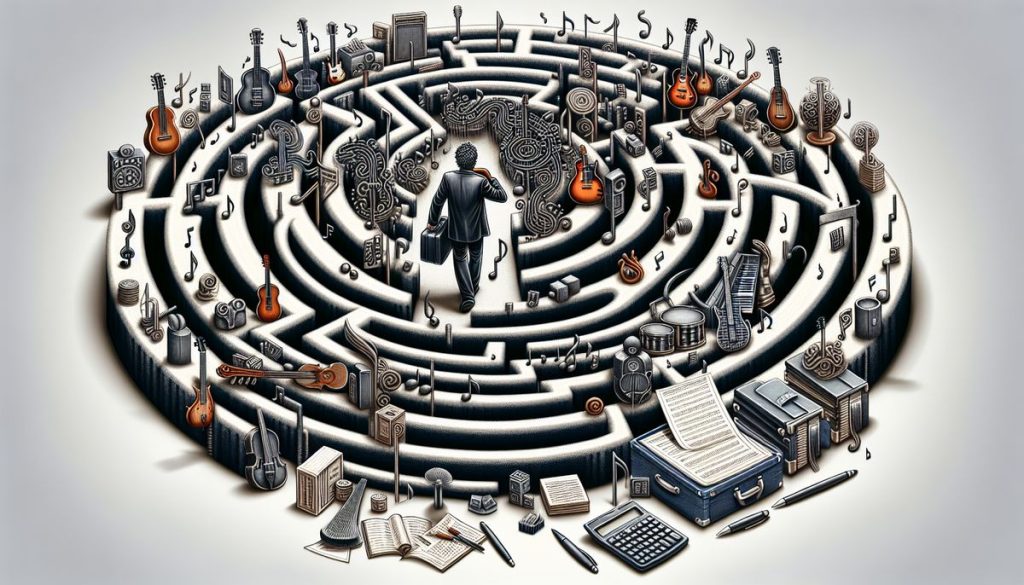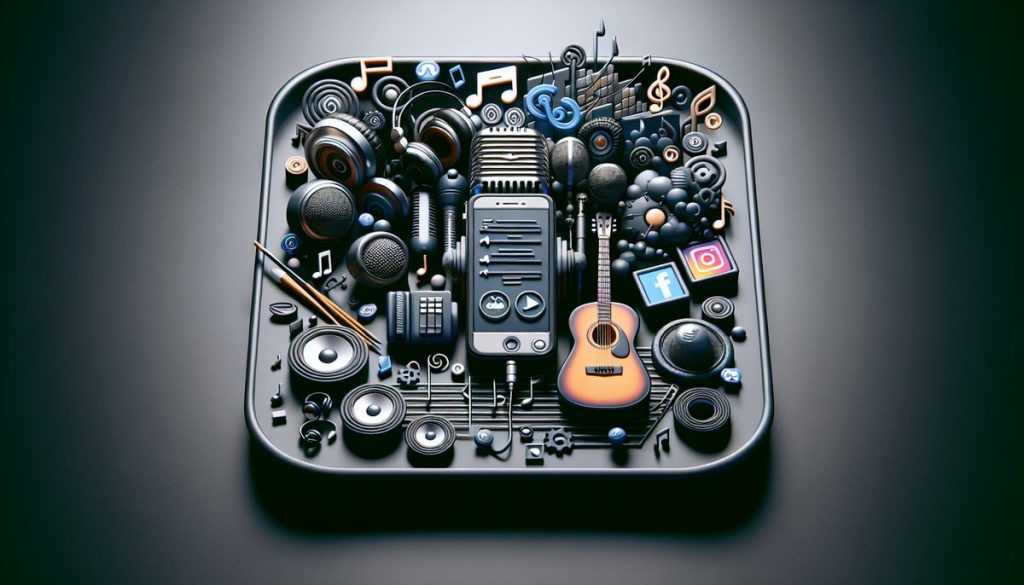Navigating Copyright and Trademark Law: Essential Tips for New Artists in the Music Industry
Written by DJ Prodigee on Tue Apr, 2024
For aspiring musicians, the journey to success involves more than just honing their musical talents; it also demands a thorough understanding of the legal landscape that safeguards their creative outputs. This article serves as a guide for emerging artists to navigate the complex terrains of copyright and trademark law in the music industry. By grasping these legal concepts, artists can protect their work, establish their brand, and strategically manage their intellectual property to avoid legal pitfalls and maximize their artistic and financial rewards.
Key Takeaways
- Understanding copyright law is crucial for artists to know what they can legally use or sample in their music without facing infringement lawsuits.
- Securing a trademark for a band’s name and logo is essential to prevent others from exploiting your brand and to protect merchandise and marketing materials.
- Navigating music royalties and contracts is key to ensuring artists are fairly compensated for their work and understand their financial rights in the industry.
- Licensing is a complex but necessary aspect of the music business; artists must understand the different types of licenses to legally cover or use songs and protect their own works.
- Staying informed about the latest developments in copyright and trademark law can help artists avoid legal issues and focus on their creative endeavors.
Copy-WHAT? Decoding the Gibberish of Copyright Law
The ABCs of Copyright: What You Can and Can’t Steal
Alright, new artists, let’s dive into the deep end of the legal pool—but don’t worry, we’ll keep the life jackets on. Copyrights are like your music’s personal bodyguards, shielding your tunes from those sneaky copycats. But before you start thinking everything is up for grabs, let’s clear up what you can (and can’t) swipe from the musical cookie jar.
Copyrights give you the exclusive right to do a bunch of cool stuff with your tunes—like reproducing, distributing, and performing them. But remember, just because you can hum it, doesn’t mean you can claim it. Here’s a quick rundown:
- Reproduce: Make copies of your tracks until the cows come home (or until your hard drive fills up).
- Distribute: Share your music with the world, or at least with your mom.
- Perform: Rock out with your songs live or in your shower—your choice.
- Display: Show off your album art or lyrics in a gallery, if that’s your jam.
- License: Let others use your music, but make sure they pay up!
Remember, with great power comes great responsibility. Don’t go on a power trip and start using other people’s work without permission—that’s a one-way ticket to lawsuit city.
And hey, don’t forget about trademarks. They’re like the cool tattoos for your band, making sure fans can spot your merch from a mile away. Just make sure your band’s name isn’t already taken, or you might have to go back to the drawing board (and possibly court).
Sampling, Remixing, and the Fine Line of Fair Use
So you’ve got a killer beat in your head, and it sounds suspiciously like that one hit from the ’80s. Before you go sampling like a kid in a candy store, remember: fair use is a fickle friend. It’s like that one guest at the party who says they’ll help clean up but vanishes when the lights come on. Fair use might cover you when you’re riffing a tune for your buddy’s history project, but when you’re aiming for the top charts, it’s a whole different ball game.
Fair use isn’t a wild card you can play whenever you feel like it. There are rules, people! For example, using a snippet for educational purposes or in a museum might be cool, but don’t think you can just swipe a melody for your next club banger. And remember, just because you call it a ‘remix’ doesn’t mean you’re in the clear.
Here’s a quick rundown of when you might be on solid ground:
- Daily news reporting (with a hat tip to the original, of course)
- Educational uses (like jamming in a classroom)
- Helping out folks with disabilities
- Cultural shindigs at heritage institutions
Remember, the key is not to cross the line from homage to rip-off. Fair use is about balance, not a free-for-all. So, before you sample that sick beat, ask yourself: is it really necessary, or are you just being lazy? Because if you end up in court, ‘I didn’t know’ won’t cut it as a defense.
Avoiding the ‘Oops, I’m Sued!’ Moment: Understanding Infringement
So you’ve got a killer tune and you’re about to drop it like it’s hot. But wait! Before you unleash your musical genius on the world, let’s make sure you’re not stepping on any legal landmines. Avoiding copyright infringement is like playing a game of hot potato with a cactus
-
it’s all fun and games until someone gets pricked. To keep your artistic hide lawsuit-free, here’s the lowdown:
-
Create Original Work: This one’s a no-brainer, but you’d be surprised how many folks think a little ‘borrowing’ won’t hurt. Spoiler alert: it will. Draw inspiration from various sources, but make sure your final masterpiece can’t be mistaken for a long-lost twin of someone else’s jam.
-
Know Your Defenses: If you’re accused of infringement, there are a few defenses you can whip out faster than a guitar solo at a rock concert. These include fair use, which lets you use bits of someone else’s work for things like criticism, comment, news reporting, teaching, scholarship, or research.
Remember, the best defense is a good offense. And by offense, I mean doing your homework and understanding what’s cool to use and what’s not.
-
Don’t Be a Troll: Seriously, don’t be that person who uses complicated licenses to trap others into infringement. It’s not a good look, and it’s definitely not rock ‘n’ roll.
-
Pay Up When You Mess Up: If you do step on someone’s toes and they come after you, be prepared to cough up some dough. The court might make you pay damages or even hand over your unsold mixtapes. Ouch.
Trademark Tunes: Branding Your Band Without a Bummer
Your Band’s Name in Lights: Securing a Trademark
So, you’ve got a band name that’s as catchy as a cold in winter, and you’re ready to slap it on everything from T-shirts to toasters. But hold your horses, rockstar! Before you print a single sticker, you need to secure that trademark. Why? Because without it, any Tom, Dick, or Harry could start their own garage band and call it the same thing. And trust me, you don’t want to share your spotlight with a bunch of copycats.
Securing a trademark is like putting a padlock on your band’s identity. It’s a legal way to say, "This name is ours, hands off!" And it’s not just about the name; it’s about the logos, the slogans, and that one-of-a-kind symbol you doodled on a napkin. Here’s a quick rundown of what you need to do:
- Launch an LLC to give your band a legit business structure.
- Register a publishing company to handle all those hit songs.
- Start a business bank account to keep your gig money safe.
- Trademark your band name to make it officially yours.
- Form a partnership agreement to keep the peace among band members.
- Submit… well, you get the idea.
Remember, a trademark is your frontman in the legal mosh pit of the music biz. It’s what helps you stand out and protects your brand from being riffed off by others.
Once you’ve got your trademark locked down, you can march to the beat of your own drum without worrying about name thieves. And when you see your band’s name in lights, you’ll know it’s not just a sign—it’s a fortress.
Merch Madness: Protecting Your Swag
So you’ve got a band name that’s stickier than bubblegum on a hot sidewalk, and your logo is cooler than a polar bear’s toenails. Now it’s time to slap that bad boy on everything from t-shirts to toasters. But hold up! Before you start printing like there’s no tomorrow, you gotta protect your swag.
Trademarks are your best pals in the merch game. They’re like the bouncers at the club of commerce, keeping the riff-raff from ripping off your brand’s vibe. Think of them as the magical spells that keep your band’s name and logo safe from the dark arts of counterfeiting.
Remember, without a trademark, you’re just tossing your brand into a pit of piranhas and hoping for the best.
Here’s a quick checklist to keep your merch protected:
- Register your trademark, stat!
- Keep an eye on the market for knock-offs.
- Get legal backup ready for any copycat showdowns.
And don’t forget, while trademarks are epic for keeping your merch yours, they don’t cover your music. That’s copyright’s turf. So, make sure you’re not mixing up your legal shields!
The No-Go’s of Logo Woes: Avoiding Trademark Infringement
So, you’ve got a band logo that’s cooler than a polar bear’s toenails, but hold your horses before you slap it on everything from T-shirts to toasters. Trademark infringement is no joke, and it can turn your rockstar dreams into a courtroom drama faster than you can say ‘cease and desist’.
First things first, let’s talk about trademarks in the music biz. They’re like the VIP pass that keeps your band’s name and logo safe from party crashers. But remember, not all logos are created equal. Here’s a quick checklist to keep your brand out of hot water:
- Ensure originality: Your logo should be as unique as your sound.
- Do your homework: Research to avoid accidental doppelgangers.
- Register, register, register: Make it official and protect it globally.
Remember, a trademark is more than just a legal formality; it’s the guardian of your band’s identity.
And if you’re thinking, ‘But what about that sick logo that looks a bit like the Stones’ tongue?’ Forget about it. Inspiration is cool, imitation is not. Stick to these tips, and you’ll navigate the trademark waters like a pro.
Royalty Ruckus: Making Sense of Music Money Matters
Show Me the Money: How Royalties Work
Ever wondered how your favorite jam turns into cold hard cash for the artists? Let’s dive into the magical world of music royalties, where every play counts and every cent matters. Royalties are the bread and butter for musicians, and they come in various flavors. From the moment a song is streamed on Spotify to the time it’s blasted on the radio, ka-ching—the cash register rings for the copyright owner.
But how does this money find its way to the artist’s pocket? It’s a journey, folks! This money is typically collected by the company distributing the music, which is then usually paid to the label, and a part of that is paid to the artist. It’s like a financial relay race where the baton of bucks gets passed along until it reaches the artist’s wallet.
Remember, not all royalties are created equal! There are mechanical royalties for when your tunes are physically or digitally reproduced, and performance royalties when your beats grace the ears of the public in various settings.
To give you a taste of the royalty pie, here’s a quick breakdown:
- Mechanical Royalties: Dough for every album sold or track downloaded.
- Performance Royalties: Moolah when your music is played in public, be it on radio, in a bar, or a live gig.
- Synchronization Royalties: Cash flow from TV shows, movies, or ads featuring your tunes.
And that’s just the tip of the iceberg. So, keep your tunes spinning and your royalty knowledge sharp!
Signing on the Dotted Line: What Your Contract Should Include
So, you’re about to ink a deal that’ll make your rockstar dreams a reality. But hold your horses, Picasso of the pentatonic scale! Before you sign away your soul—or worse, your royalties—make sure your contract isn’t a one-way ticket to Splitsville with your profits. First things first: ownership is key. Who owns the master recordings? If it’s not you, you might just be the opening act in your own career.
Let’s talk turkey—advances and recoupment. That fat check they’re waving in your face? It’s not a gift; it’s a loan against your future earnings. And trust me, they’ll want every penny back before you see dime one in royalties. Speaking of which, get those royalty rates etched in stone. A vague promise of ‘a fair share’ won’t keep the lights on when you’re streaming gold but banking bronze.
Here’s a little cheat sheet for your back pocket:
- Ownership of master recordings
- Advance payment details and recoupment terms
- Royalty rates and calculation methods
- Duration of the agreement
- Rights and obligations of each party
Remember, a good contract is like a prenup for your music marriage—it’s not romantic, but it’ll save you from heartache (and an empty wallet) down the line.
Streaming and Screaming: Navigating Digital Platforms
Welcome to the wild world of digital platforms, where the only thing growing faster than your fanbase is the number of streaming services! Navigating the digital music scene is like trying to ride a unicycle on a tightrope – it’s all about balance and not falling into the abyss of obscurity.
So, you’ve got your tunes ready to drop faster than a cat meme goes viral, but where to start? Here’s a pro tip: diversify your platforms. Don’t put all your eggs in one app basket. You’ve got Spotify, Apple Music, Tidal, and that’s just the tip of the iceberg. Each platform has its quirks, and you’ll want to play nice with all of them to maximize your exposure.
- Spotify: Your go-to for playlist fame.
- Apple Music: For the cool kids with iPhones.
- Tidal: High-fidelity streams for the audiophiles.
Remember, it’s not just about uploading and ghosting. Engage with your fans! Comment, like, and share. It’s the digital equivalent of high-fiving your audience after a killer set.
And let’s not forget the money talk. Streaming might not make you a billionaire, but it’s a solid way to rake in some dough. Just make sure you understand the royalty system – it’s more complex than your relationship status. Keep an eye on those music royalties and rights to ensure you’re not just making noise, but also making bank.
Cover Your Tracks: Licensing and Legal Loopholes
Cover Songs and Copyright: Paying Homage Without Paying a Fortune
So you want to cover ‘Bohemian Rhapsody’ and not end up like a poor boy nobody loves in the eyes of the law? Cover songs and trademark tunes are a minefield of ‘don’t step here’ signs. But fear not, with a bit of know-how, you can navigate this labyrinth without blowing up your bank account.
First things first, let’s talk about the dual nature of a song’s copyright. There’s the sound recording—think of it as the ‘cover’ of the book—and the musical composition, which is the juicy story inside. To legally cover a song, you’ll need to get licenses for both these aspects. And yes, that means shelling out some cash for royalties.
- License 1: Musical Composition
- License 2: Sound Recording
Streaming platforms like Spotify are like the cool kids’ table—you want to sit there, but it costs you every time your track gets played. And if you’re thinking of blasting your cover in a coffee shop or through a YouTube video, remember, the original creators want their slice of the pie too.
Remember, getting the right licenses is like getting a backstage pass. Without it, you’re just a fan in the nosebleed section, dreaming of the spotlight.
Understanding copyright and trademark law is not just for the bookworms or the goody two-shoes. It’s for anyone who doesn’t want to wake up to a lawsuit instead of an alarm clock. So, get those licenses, pay those royalties, and maybe trademark your band name while you’re at it. It’s the rockstar way to do business!
Sync or Swim: Understanding Synchronization Licenses
Dive into the world of synchronization licenses, and you’ll find it’s less about doing the backstroke and more about not drowning in legal jargon. A sync license is your golden ticket to using someone else’s tune in your visual masterpiece, be it a film, a commercial, or that indie game you’ve been coding in your basement.
But before you start syncing, remember this: without a sync license, you’re basically a fish out of water. Here’s a quick checklist to keep you afloat:
- Identify the copyright holder of the music
- Negotiate the terms (and the price!)
- Secure the license before your content goes public
Remember, a sync license isn’t just a nice-to-have; it’s a must-have unless you fancy a legal kerfuffle.
Whether you’re a rookie filmmaker or a seasoned ad exec, getting your hands on a sync license is crucial. It’s the difference between your content being a hit or a lawsuit waiting to happen. So, make sure you’ve got your legal lifejacket on tight!
The Maze of Music Licensing: What You Need to Know
Ever felt like you’re trying to solve a Rubik’s Cube in the dark when it comes to music licensing? You’re not alone. Music licensing is the gatekeeper that stands between your tunes and the big, wide world of media. Navigating this maze is crucial, because without the right licenses, your music is going nowhere fast – except maybe into a lawsuit.
Here’s a quick rundown to keep you on the right track:
- Performance Licenses: These are your golden tickets for live performances and radio play. Think of them as your backstage pass to the airwaves.
- Mechanical Licenses: Want to record and distribute a cover song? You’ll need one of these bad boys to legally press play on production.
- Synchronization Licenses: Sync or swim, folks. If you want your music in films, TV, or ads, you’ll need to sync up with one of these licenses.
- Licensing Organizations: ASCAP, BMI, SESAC – they’re not just random letters, they’re your BFFs in the licensing world. Get to know them!
Remember, each type of license serves a different purpose, and you might need more than one to cover all your bases. It’s like a combo meal – you want the full deal, not just the fries.
So, before you hit the stage or the studio, make sure you’ve got your licensing lined up. It’s the difference between making sweet music and facing a sour note in court.
Drop the Mic, Not Your Rights!
Alright, rockstars and pop divas, we’ve jammed through the legalese and hit the high notes of copyright and trademark law faster than a one-hit wonder climbs the charts. Remember, your music isn’t just about sick beats and catchy hooks—it’s a treasure trove of intellectual property that deserves ironclad protection. So, before you strut your stuff on the world stage, make sure your legal ducks are in a row. Get those copyrights and trademarks sorted, or you might find your next gig is playing ‘Jailhouse Rock’ with a cellmate named Bubba. Keep your brand as unique as your sound, and you’ll be more untouchable than a diva’s high note. Now go forth, unleash your inner music mogul, and let the royalties roll in like fan mail!
Frequently Asked Questions
What are the basics of copyright law for musicians?
Copyright law protects original works of authorship, including songs, lyrics, and recordings. As a musician, you have exclusive rights to reproduce, distribute, and perform your music. However, you can’t use someone else’s copyrighted work without permission, except under fair use conditions.
Can I sample another artist’s music legally?
Sampling music typically requires permission from the copyright holder. Without permission, it’s considered infringement, unless it qualifies as fair use, which is determined by factors like the purpose of use and the amount sampled.
How do I trademark my band’s name and logo?
To trademark your band’s name and logo, you need to file an application with the appropriate trademark office, such as the USPTO in the United States. It’s important to ensure the name and logo are unique and not already in use.
What should I look for in a music contract regarding royalties?
Your music contract should clearly define how royalties are calculated, the percentage you’ll receive, the payment schedule, and any deductions. It should also specify royalties for different formats and platforms.
Do I need a license to cover someone else’s song?
Yes, to legally release a cover song, you typically need a mechanical license from the copyright holder. This grants you the right to reproduce and distribute the song.
What is a synchronization license, and when do I need one?
A synchronization license is required when you want to use a piece of music in sync with visual media, like in a film, TV show, or commercial. You need this license any time you wish to pair music with visuals in a public setting.





